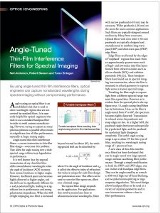-
Tunable Bandpass Filters
by IDEX Health & ScienceMany applications benefit from tunable optical filters with the spectral and two-dimensional imaging performance characteristics of thin-film filters and the center wavelength tuning flexibility of a diffraction grating.
Full story
-
Thin-Film Filters for Raman Spectroscopy
by IDEX Health & ScienceRecent advances in thin-film filter technology have enabled dramatic improvements in the performance of filters for laser-based analytical instrumentation.
Full story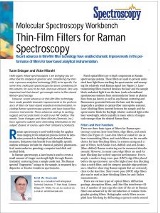
-
Thin-Film Filters Come of Age
by IDEX Health & ScienceMultilayer optical thin-film filters play a critical role in applications ranging from biomedical and analytical instrumentation to advanced laser systems. Learn why thin-film coating technology has been a technological breakthrough in biotechnology and other fields.
Full story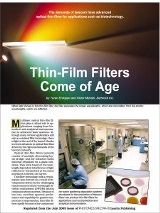
-
The Story of Semrock
by IDEX Health & ScienceDiscover how the Semrock optical filters business was started back in 2000.
Full story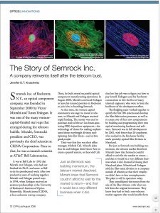
-
The Emergence of Multimodal NLO
by IDEX Health & ScienceMultimodal nonlinear optical (NLO) imaging is a microscopy approach used in a variety of biomedical applications. It harnesses and integrates the unique capabilities of nonlinear processes such as multiphoton fluorescence, second- and third-harmonic generation (SHG and THG), and coherent Raman scattering (CRS) and combines them seamlessly into a single, unified microscopy platform.
Full story
-
Steep Edges for the Finest Fingerprints
by IDEX Health & ScienceOptical edge filters are critical to the performance of Raman detection systems. This article describes two families of long‐wave‐pass (LWP) edge filters that Semrock has developed specifically for Stokes‐shift backscattered Raman signal detection systems. These filters are used in commercial Raman systems for polymer science, thin film analysis, geoscience, and the pharmaceutical industry
Full story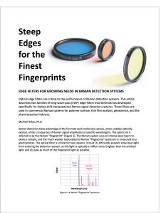
-
Photovoltaics: Raman Spec Monitors Thin-Film Si PV Cell Manufacture
by IDEX Health & ScienceThin-film silicon (Si) photovoltaics are a combination of amorphous and microcrystalline Si; monitoring the proportions via Raman spectroscopy and high-performance optical filters allows the cells to be optimized during manufacture.
Full story
-
Perfecting TIRF Optics
by IDEX Health & ScienceIncreasingly popular, total-internal-reflection-fluorescence (TIRF) microscopy systems prefer lasers for excitation because of their spectral purity and brightness. But the use of lasers can restrict other TIRF system components. Clearing these hurdles requires some careful considerations.
Full story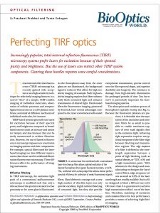
-
Orange Laser Sources for Life Sciences Research
by IDEX Health & Science594-nm laser excitation can enhance our ability to analyze cells by flow cytometry. This laser wavelength fills a significant excitation gap between the now common 561-nm line and the red laser sources. Adding this wavelength to the excitation repertoire enables excitation of virtually any visible fluorescent probe for cytometric analysis.
Full story
-
Optimization of Flow Cytometric Detection and Cell Sorting of Transgenic Plasmodium Parasites using Interchangeable Optical Filters
by IDEX Health & ScienceFilter optimization is particularly important for applications where the FP signal and percentage of positive events are relatively low. In this article discover how the results substantially improved yield of GFP-expressing parasites, and requires decreased sorting time in comparison to standard methods.
Full story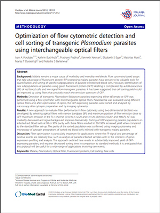
-
Optics fabrication: High-performance mirrors excel for intracavity applications
by IDEX Health & ScienceWith carefully controlled absorption and scattering losses, high-reflectivity, low-loss dielectric mirrors enable demanding applications such as gravitational-wave detection and cavity ring-down spectroscopy.
Full story
-
Optical Filters Impact Fluorescence Fidelity
by IDEX Health & ScienceOptical filters are crucial in fluorescence experiments and instrumentation. Explore recent advances in filter technology offer a way to improve fluorescence techniques in this journal article.
Full story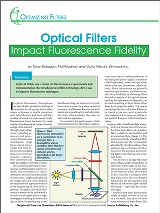
-
Optical Filters Go Deeper
by IDEX Health & ScienceOptical filters with good performance in the mid-UV are crucial for enabling important new instruments based on applications including biochemical absorption, fluorescence and spectroscopy, as well as for realizing the full potential of industrial applications in areas including UV sterilization, and semiconductor and electronics manufacturing.
Full story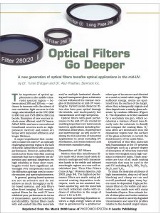
-
Optical Filters For Multiphoton Microscopy
by IDEX Health & ScienceAdvances in filter technology enable improved multiphoton microscopy performance. Learn more about optical filters for multiphoton microscopy in this article for BioPhotonics.
Full story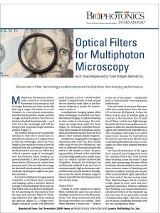
-
Optical Coatings Industry: the Picture Looks Bright
by IDEX Health & ScienceThe development of reliable “hard” coatings for complex optical filters was an important trend in the optical coatings industry. Discover why areas such as biotechnology and analytical instrumentation shifted towards hard-coated filters to benefit not only from their performance, but also from their lasting reliability and durability.
Full story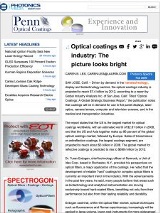
-
New Optical Filters Improve High-Speed Multicolor Fluorescence Imaging
by IDEX Health & ScienceBased on ion-beam sputtering of hard oxide glass materials, the novel filters provide higher system brightness and sensitivity. Fluorescence microscopy is ideal for biological imaging because it reveals only objects of interest in an otherwise dark background, while permitting selective tagging. Learn more by exploring this journal article for BioPhotonics.
Full story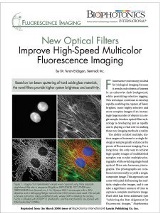
-
Large Optics: Petawatt high-LIDT coatings don’t sacrifice performance
by IDEX Health & ScienceHigh laser-induced damage threshold (LIDT) optical coatings help enable the highest-peak-power lasers in existence.
Full story
-
Fluorescence Imaging: Optical filters optimize laser-based fluorescence imaging systems
by IDEX Health & ScienceThe advent of lasers as fluorescence light sources imposes new constraints and demands on the optical filters required for optimal operation of these laser-based imaging systems.
Full story
-
Bringing Superresolution to Fluorescence Microscopy
by IDEX Health & ScienceEfforts are under way to enhance the superresolution not only laterally but also axially. Rather than having to develop and use specialized fluorophores, many researchers have demonstrated the advantages of using standard fluorophores, expanding the applicability of super-resolution techniques.
Full story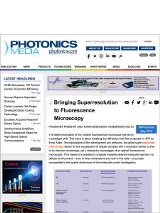
-
Angle-Tuned Thin-Film Interference Filters for Spectral Imaging
by IDEX Health & ScienceBy using angle-tuned thin-film interference filters, optical engineers can capture nonstandard wavelengths during spectral imaging without compromising performance. Download this resource from OPN Optics & Photonics News now to learn more.
Full story